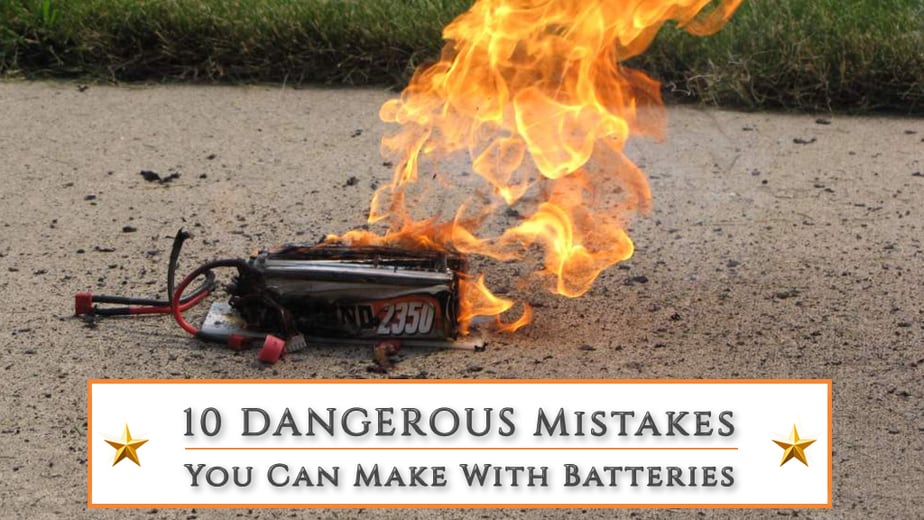
LiPo batteries are on almost every laptop, every camera, every cellphone, every Bluetooth speaker… and now, they’re on pretty much all our electric RCs. But in electric RCs, we have a lot of control over what kind of batteries to get, and how to charge them.
So there’s no question about it, they have made our lives better, and they are relatively safe, but they can be dangerous if they are not correctly handled and cared for.
Today we’re going to look at 10 of the more dangerous mistakes you can make when handling LiPo batteries, but most importantly, how to use them correctly whilst staying safe.
Charging
So, the number #1 dangerous mistake is charging them incorrectly, or using a cheap and unsafe charger – which is much more common than it should be.
LiPo batteries are at their most dangerous when they’re fully charged, or when they’re charging, because they’re packed full of energy – so, it’s critical that each cell is at 4.2 volts. If you charge them as nickel metal hydride, as NiCad, or if you specify the wrong number of cells, it will overcharge them, and when you overcharge them, they will hiss and detonate, and catch on fire.
If you have a poor quality $10 or $15 cheap charger for example, and it doesn’t shut off when it’s supposed to, even though it’s a trickle charge, they can will light on fire, and it’s usually a very intense fire.
Disposing
Number #2 is disposing a fully charged battery in the trash. So, let’s say you have a battery which has been fully charged, you slot it in your drone and try to fly it, but realise it’s not as punchy as you’d like or perhaps it runs down quicker than you’d like… so you give up on it as you’ve got a few others and throw it in the trash.
If you throw it in the garbage fully charged, or even close to fully charged, it’s basically like a little bomb, like a little stick of dynamite that you’re throwing away. And of course what does a garbage man do? Puts in the truck then compacts it.
The problem with compacting is these LiPos have a sheath protecting the actual lithium polymer from the air. Once it’s penetrated, it can easily catch on fire, and the more charged it is, the more it will catch on fire, and the more intense the fire will be.
There’s actually been a lot of cases in the news about garbage men unknowingly putting the garbage can in the truck, then compacting the contents, and it detonating within minutes, often with an intense fire developing.
And one of the reasons this happens is people disposing of batteries in a fully charged manner, without thinking about it or worse, just not knowing how dangerous the situation could be.
So what do you want to do in this position? Simple, you want to do what’s called discharging the battery. You want to discharge it using your charger discharger – and when you understand how to do it with your charger, and then you can dump it safely.
Keeping Damaged Batteries
Number #3 is keeping puffy and damaged batteries, especially when you know you’re not going to use them again.
When a LiPo battery is stressed, when the polymers are compromised, it gets fat and often it’s only a matter of time before they become super fat. And when it’s super fat, it’s at a very stressed level so you must dispose of it immediately, but safely.
Another thing to consider is when these damaged batteries are being kept in your car or your drone carry case, and you don’t know for sure just how damaged they really are – it’s time to dispose of them.
The reason being, once that sheet gets compromised, it has the potential to blow up and this will result a very intense fire will happen.
So the simple rule is, once your batteries are compromised, you must get rid of them.
Fully Charged Storage (for long periods of time)
Number #4 is storing your batteries fully charged for long periods of time.
So, this is a three-cell 11.1 volt. Fully charged, it holds a charge of 12.6 volts. Every time you use it, you charge it 12.6 volts, right? And that’s good. It can hold that charge safely for a day or two. But let’s say you’re packing up for the winter, don’t leave your batteries at 12.6 volts, because the longer it stays at that charge, the more it degrades. So, every day that you do it, or every month, it’s degrading. So come next season, your battery is not that good.
So, what you’re going to do is you put it in storage mode, which is 3.7 volts per cell. So, understand your charger, put it right there. You don’t want to discharge it. You don’t want to fully charge it. You want to keep it right in the middle so it has a little bit of wiggle room as it discharges sensitively to temperature and whatnot, and be in a healthy state once you’re ready to use it.
LiPo Cutoff
Number #5 is using a LiPo cutoff that is too low. What is LiPo cutoff? So, these batteries are safe between 3 volts and 4.2 volts. 4.2, they catch on fire. 3 volts, they become useless. So, your ESC, the piece of electronic across the battery knows this, a good one, and says, “Okay, you’re at this certain level, you’re at 3.2 volts, let me cut you off now.” So, you want to give yourself a safe margin. Don’t put it at 3 volts, even though that is the limit. Maybe put it at 3.2 volts, 3.4 volts. That way, when you hit that level, it will shut off, and you have a lot room, wiggle room to keep your battery safe. And it’ll help the longevity of your battery.
Flammable Charging
Number #6 is charging your batteries in a flammable area and next to each other, unattended.
When you charge a LiPo battery, it’s actually in its most unsafe period at that time, so always best to isolate it. The ideal way to do this is to put it on a cement floor, perhaps in your garage. That way, if anything unthinkable such as it catching on fire does happen, it’s manageable.
Another good way to charge your battery is to put it on your barbecue grill outside, close the lid and charge it in there – obviously make sure any gas bottles are turned off – and remember to time when you need to remove it.
Or better yet, buy a LiPo safe charging box and charge it there. That way, if something does happen, then you have the charging box to protect the surrounding area.
One of the worst things you can do is put it on a wood shelf, as the shelf could catch on fire, and before you know it the whole area is out of control.
But the absolute worst thing you can do is charge multiple batteries at the same time, in the same area. If one was to catch on fire, that is enough to penetrate the sheet of all the other batteries, and everything will then likely catch on fire. So charge them in a safe place and away from each other.
Multiple Batteries
Number #7 is buying and using just one LiPo battery (and we do appreciate this can be driven by your budgets).
So why is that bad? Because you will be stressing the battery by playing with it, draining it, charging it (often as fast as you can)… then putting it back in your drone, playing with it some more, and then repeating the cycle.
What’s happening is you are draining the battery very quickly, heating it up, charging it up, heating it up again, playing with it again, heating it. That’s putting stress on the battery, which can lead to problems, and in particular degradation of your battery cell.
So why not have two, or more? That way, you’re balancing the workload so to speak, or spreading the workload between your batteries.
C Rating
Number #8 is not buying enough C rating for your application. So, the C rating is this big number here that says C. So, three-cell, eco power, 45C. So, 45C means something, 45 times 2,200 is the amount of amps it can deliver. And what you want to do is you want to be in the safe zone. If this has the capability to do 100 watts, discharge 100 watts. You never want to be wanting 100, 110, 120 watts. You don’t want to put this in your X-Maxx, so to speak, and really stressing it out. You want to be about half that, really. And that way, you’re in the sweet spot, you’re in the comfort zone of your battery. So if you’re getting close, buy a battery with more C rating, more discharge, or more usage rating. That way, you’re never stressing it out, heating it out. What happens when you get really close to the C rating is the battery heats up, and then the battery will puff up, then it’s compromised, and you have to get rid of it.
Battery Cool Down
Number #9 is not letting the battery cool down. So like the example I’ve stated earlier, you use it, you had so much fun with it, it gets hot, put it in a charger, charge it really fast, and then it gets even hotter. So, heat is the enemy of the battery. When it’s getting hot, it’s not happy. When it’s warm, it’s telling you it’s working. When it’s hot, hot to the touch, let it rest. Stay away from it, put it in the bag of ice, give it a break, okay. Let it recover. Heat is its enemy. It’s going to get stressed out. It’s going to pop up, or catch on fire, which is kind of remote, but it’s going to damage itself. So, let your batteries cool down. And the best way to do that, especially when you’re in a very high stress or hot climate, is have more than one.
Balance Charge
And number #10 is not balance charging your LiPo battery correctly.
So with balance charging, all the three cells have to be balanced, because if they’re not, the peak voltage of your three-cell 12.6 volts can be unevenly distributed between the cells. One cell can be at 4.5 volts, meaning it’s in the danger zone when you want them all at 4.2 equally.
Balance charging will ensure that no errors are made. Balance charging will ensure that you’re not charging it as nickel metal hydride, or the wrong number of cells. Balance charging is your checks and balances so to speak. It will take a little longer, but it’s worth it, and if you do want it to be faster, simply buy a more expensive charger.
